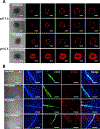Macrophage-Membrane-Coated Nanoparticles for Tumor-Targeted Chemotherapy
- PMID: 29473753
- PMCID: PMC7470025
- DOI: 10.1021/acs.nanolett.7b05263
Macrophage-Membrane-Coated Nanoparticles for Tumor-Targeted Chemotherapy
Abstract
Various delivery vectors have been integrated within biologically derived membrane systems to extend their residential time and reduce their reticuloendothelial system (RES) clearance during systemic circulation. However, rational design is still needed to further improve the in situ penetration efficiency of chemo-drug-loaded membrane delivery-system formulations and their release profiles at the tumor site. Here, a macrophage-membrane-coated nanoparticle is developed for tumor-targeted chemotherapy delivery with a controlled release profile in response to tumor microenvironment stimuli. Upon fulfilling its mission of tumor homing and RES evasion, the macrophage-membrane coating can be shed via morphological changes driven by extracellular microenvironment stimuli. The nanoparticles discharged from the outer membrane coating show penetration efficiency enhanced by their size advantage and surface modifications. After internalization by the tumor cells, the loaded drug is quickly released from the nanoparticles in response to the endosome pH. The designed macrophage-membrane-coated nanoparticle (cskc-PPiP/PTX@Ma) exhibits an enhanced therapeutic effect inherited from both membrane-derived tumor homing and step-by-step controlled drug release. Thus, the combination of a biomimetic cell membrane and a cascade-responsive polymeric nanoparticle embodies an effective drug delivery system tailored to the tumor microenvironment.
Keywords: biomimetic delivery system; breast-cancer targeting; cascade-responsiveness; macrophage-membrane coating; tumor microenvironment.
Conflict of interest statement
The authors declare no competing financial interest.
Figures




Similar articles
-
Paclitaxel-Loaded Macrophage Membrane Camouflaged Albumin Nanoparticles for Targeted Cancer Therapy.Int J Nanomedicine. 2020 Mar 19;15:1915-1928. doi: 10.2147/IJN.S244849. eCollection 2020. Int J Nanomedicine. 2020. PMID: 32256068 Free PMC article.
-
Enhanced drug-loading and therapeutic efficacy of hydrotropic oligomer-conjugated glycol chitosan nanoparticles for tumor-targeted paclitaxel delivery.J Control Release. 2013 Dec 28;172(3):823-31. doi: 10.1016/j.jconrel.2013.08.297. Epub 2013 Sep 11. J Control Release. 2013. PMID: 24035978
-
Nanoplatform Assembled from a CD44-Targeted Prodrug and Smart Liposomes for Dual Targeting of Tumor Microenvironment and Cancer Cells.ACS Nano. 2018 Feb 27;12(2):1519-1536. doi: 10.1021/acsnano.7b08051. Epub 2018 Jan 24. ACS Nano. 2018. PMID: 29350904
-
Macrophage membrane coated nanoparticles: a biomimetic approach for enhanced and targeted delivery.Biomater Sci. 2022 Mar 2;10(5):1193-1208. doi: 10.1039/d1bm01664d. Biomater Sci. 2022. PMID: 35122479 Review.
-
Coating nanoparticles with cell membranes for targeted drug delivery.J Drug Target. 2015;23(7-8):619-26. doi: 10.3109/1061186X.2015.1052074. J Drug Target. 2015. PMID: 26453159 Review.
Cited by
-
Nanomedicine approaches to reduce cytokine storms in severe infections.Drug Discov Today. 2022 Nov;27(11):103355. doi: 10.1016/j.drudis.2022.103355. Epub 2022 Sep 12. Drug Discov Today. 2022. PMID: 36099962 Free PMC article. Review.
-
Advancements in strategies for overcoming the blood-brain barrier to deliver brain-targeted drugs.Front Aging Neurosci. 2024 Aug 26;16:1353003. doi: 10.3389/fnagi.2024.1353003. eCollection 2024. Front Aging Neurosci. 2024. PMID: 39253614 Free PMC article. Review.
-
M1 macrophage-membrane-cloaked paclitaxel/β-elemene nanoparticles targeting cervical cancer for enhanced therapy.Int J Pharm X. 2024 Aug 13;8:100276. doi: 10.1016/j.ijpx.2024.100276. eCollection 2024 Dec. Int J Pharm X. 2024. PMID: 39263001 Free PMC article.
-
Intravenous route to choroidal neovascularization by macrophage-disguised nanocarriers for mTOR modulation.Acta Pharm Sin B. 2022 May;12(5):2506-2521. doi: 10.1016/j.apsb.2021.10.022. Epub 2021 Oct 28. Acta Pharm Sin B. 2022. PMID: 35646523 Free PMC article.
-
Cell Membrane-Camouflaged Nanocarriers for Cancer Diagnostic and Therapeutic.Front Pharmacol. 2020 Feb 4;11:24. doi: 10.3389/fphar.2020.00024. eCollection 2020. Front Pharmacol. 2020. PMID: 32116701 Free PMC article. Review.
References
-
- Cai K; Wang AZ; Yin L; Cheng JJ Control. Release 2017, 263, 211–222. - PubMed
-
- Ryan SM; Brayden DJ Curr. Opin. Pharmacol 2014, 18, 120–8. - PubMed
-
- Magana IB; Yendluri RB; Adhikari P; Goodrich GP; Schwartz JA; Sherer EA; O’Neal DP Ther. Deliv 2015, 6, 777–83. - PubMed
-
- Knop K; Hoogenboom R; Fischer D; Schubert US Angew. Chem. Int. Ed. Engl 2010, 49, 6288–308. - PubMed
Publication types
MeSH terms
Substances
Grants and funding
LinkOut - more resources
Full Text Sources
Other Literature Sources
Medical

